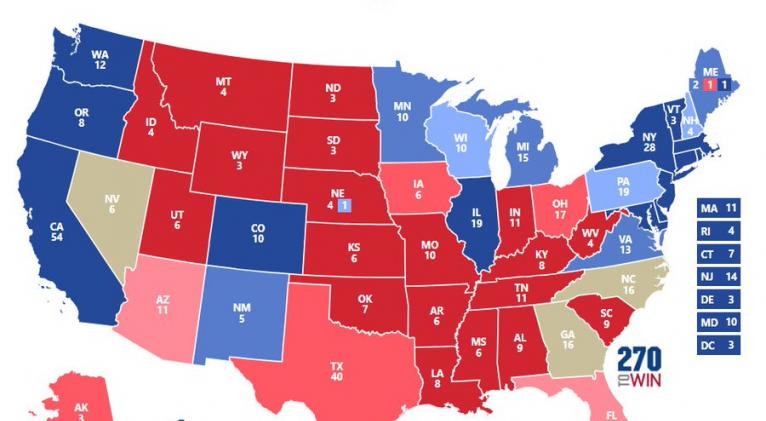US election polls: Who is ahead - Harris or Trump?
especiales

Voters in the US go to the polls on 5 November to elect their next president.
The election was initially a rematch of 2020 but it was upended in July when President Joe Biden ended his campaign and endorsed Vice-President Kamala Harris.
The big question now is - will the result mean a second Donald Trump term or America’s first woman president?
As election day approaches, we'll be keeping track of the polls and seeing what effect big events like Tuesday’s presidential debate have on the race for the White House.
Who is leading national polls?
In the months leading up to Biden’s decision to drop out of the race, polls consistently showed him trailing former president Trump. Although hypothetical at the time, several polls suggested Harris wouldn’t fare much better.
But the race tightened after she hit the campaign trail and she developed a small lead over her rival in an average of national polls that she has maintained since. The latest national polling averages for the two candidates are shown below, rounded to the nearest whole number.
In the poll tracker chart below, the trend lines show how those averages have changed since Harris entered the race and the dots show the spread of the individual poll results.
Harris hit 47% during her party’s four-day convention in Chicago, which she brought to a close on 22 August with a speech promising a "new way forward" for all Americans. Her numbers have moved very little since then.
Trump’s average has also remained relatively steady, hovering around 44%, and there was no significant boost from the endorsement of Robert F Kennedy, who ended his independent candidacy on 23 August.
While these national polls are a useful guide as to how popular a candidate is across the country as a whole, they're not necessarily an accurate way to predict the result of the election.
That's because the US uses an electoral college system to elect its president, so winning the most votes can be less important than where they are won.
There are 50 states in the US but because most of them nearly always vote for the same party, in reality there are just a handful where both candidates stand a chance of winning. These are the places where the election will be won and lost and are known as battleground states.
Who is winning in battleground states?
Right now, the polls are very tight in the seven battleground states, which makes it hard to know who is really leading the race. There are fewer state polls than national polls so we have less data to work with and every poll has a margin of error that means the numbers could be higher or lower.
As is stands, recent polls suggest there is less than one percentage point separating the two candidates in some states. That includes Pennsylvania, which is key as it has the highest number of electoral votes on offer and therefore makes it easier for the winner to reach the 270 votes needed.
Pennsylvania, Michigan and Wisconsin had all been Democratic strongholds before Trump turned them red on his path to winning the presidency in 2016. Biden retook them in 2020 and if Harris can do the same this year then she will be on course to win the election.
In a sign of how the race has changed since Harris became the Democratic nominee, on the day Joe Biden quit the race he was trailing Trump by nearly five percentage points on average in these seven battleground states.
How are these averages created?
The figures we have used in the graphics above are averages created by polling analysis website 538, which is part of American news network ABC News. To create them, 538 collect the data from individual polls carried out both nationally and in battleground states by lots of polling companies.
As part of their quality control, 538 only include polls from companies that meet certain criteria, like being transparent about how many people they polled, when the poll was carried out and how the poll was conducted (telephone calls, text message, online, etc).
You can read more about the 538 methodology here.
Can we trust the polls?
At the moment, the polls suggest that Kamala Harris and Donald Trump are within a couple of percentage points of each other both nationally and in battleground states - and when the race is that close, it’s very hard to predict winners.
Polls underestimated support for Trump in both 2016 and 2020. Polling companies will be trying to fix that problem in a number of ways, including how to make their results reflect the make-up of the voting population.
Those adjustments are difficult to get right and pollsters still have to make educated guesses about other factors like who will actually turn up to vote on 5 November.
Written and produced by Mike Hills and Libby Rogers. Design by Joy Roxas.














Add new comment